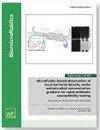胆汁动力学和基于微流控的成分检测综述:增进对胆道胆石发病机制的了解
IF 2.4
4区 工程技术
Q2 BIOCHEMICAL RESEARCH METHODS
引用次数: 0
摘要
胆石是胆囊或胆道中发现的固体肿块,会阻碍胆汁的正常流动,最终导致危及生命的严重并发症。研究表明,胆石的形成可能与胆汁流动动力学和胆汁成分的浓度水平有关。胆道中的胆汁流动动力学在揭示胆汁淤积和运输机制方面起着至关重要的作用。胆汁成分的浓度与成核和结晶等过程密切相关。近年来,与传统的台式检测方法相比,基于微流控技术的生物传感器具有样品消耗少、便携性强、成本低、实时检测灵敏度高等多重优势,因此备受青睐。在此,我们回顾了胆汁动力学研究和基于微流控技术的胆汁成分检测方法的发展。这些研究可能会对胆石的形成机制和更好的治疗提供有价值的见解,同时我们也对胆石体外碎石药物筛选和胆汁特征检测的未来发展提出了自己的看法。本文章由计算机程序翻译,如有差异,请以英文原文为准。
Review on bile dynamics and microfluidic-based component detection: Advancing the understanding of bilestone pathogenesis in the biliary tract
Bilestones are solid masses found in the gallbladder or biliary tract, which block the normal bile flow and eventually result in severe life-threatening complications. Studies have shown that bilestone formation may be related to bile flow dynamics and the concentration level of bile components. The bile flow dynamics in the biliary tract play a critical role in disclosing the mechanism of bile stasis and transportation. The concentration of bile composition is closely associated with processes such as nucleation and crystallization. Recently, microfluidic-based biosensors have been favored for multiple advantages over traditional benchtop detection assays for their less sample consumption, portability, low cost, and high sensitivity for real-time detection. Here, we reviewed the developments in bile dynamics study and microfluidics-based bile component detection methods. These studies may provide valuable insights into the bilestone formation mechanisms and better treatment, alongside our opinions on the future development of in vitro lithotriptic drug screening of bilestones and bile characterization tests.
求助全文
通过发布文献求助,成功后即可免费获取论文全文。
去求助
来源期刊

Biomicrofluidics
生物-纳米科技
CiteScore
5.80
自引率
3.10%
发文量
68
审稿时长
1.3 months
期刊介绍:
Biomicrofluidics (BMF) is an online-only journal published by AIP Publishing to rapidly disseminate research in fundamental physicochemical mechanisms associated with microfluidic and nanofluidic phenomena. BMF also publishes research in unique microfluidic and nanofluidic techniques for diagnostic, medical, biological, pharmaceutical, environmental, and chemical applications.
BMF offers quick publication, multimedia capability, and worldwide circulation among academic, national, and industrial laboratories. With a primary focus on high-quality original research articles, BMF also organizes special sections that help explain and define specific challenges unique to the interdisciplinary field of biomicrofluidics.
Microfluidic and nanofluidic actuation (electrokinetics, acoustofluidics, optofluidics, capillary)
Liquid Biopsy (microRNA profiling, circulating tumor cell isolation, exosome isolation, circulating tumor DNA quantification)
Cell sorting, manipulation, and transfection (di/electrophoresis, magnetic beads, optical traps, electroporation)
Molecular Separation and Concentration (isotachophoresis, concentration polarization, di/electrophoresis, magnetic beads, nanoparticles)
Cell culture and analysis(single cell assays, stimuli response, stem cell transfection)
Genomic and proteomic analysis (rapid gene sequencing, DNA/protein/carbohydrate arrays)
Biosensors (immuno-assay, nucleic acid fluorescent assay, colorimetric assay, enzyme amplification, plasmonic and Raman nano-reporter, molecular beacon, FRET, aptamer, nanopore, optical fibers)
Biophysical transport and characterization (DNA, single protein, ion channel and membrane dynamics, cell motility and communication mechanisms, electrophysiology, patch clamping). Etc...
 求助内容:
求助内容: 应助结果提醒方式:
应助结果提醒方式:


